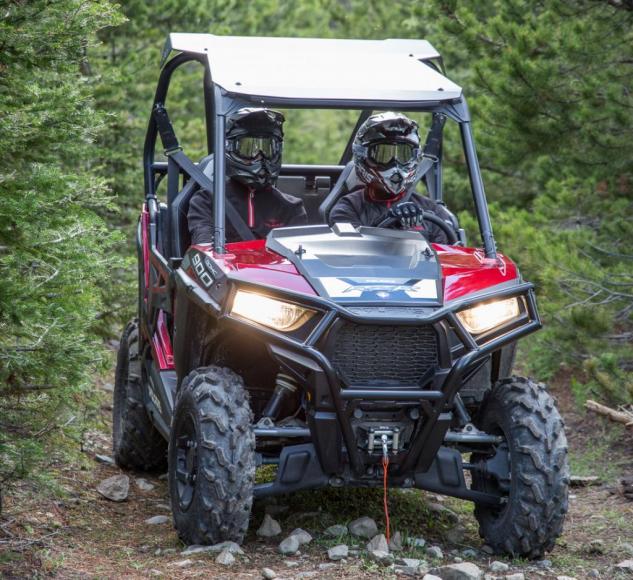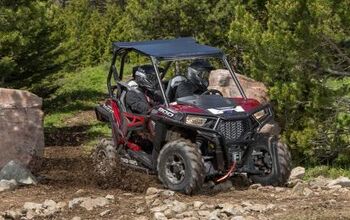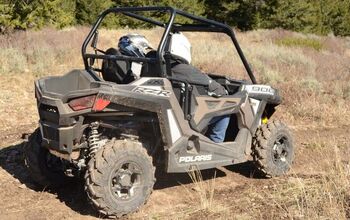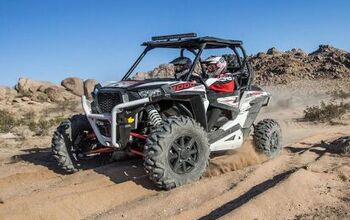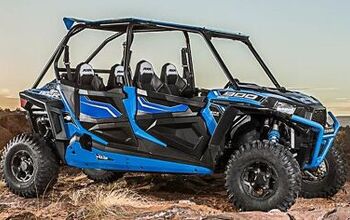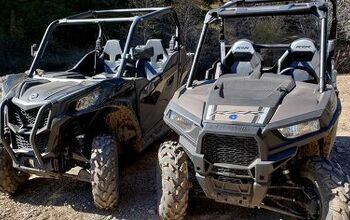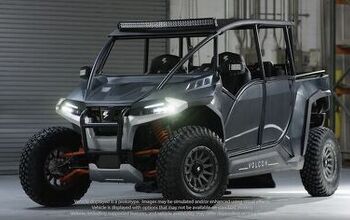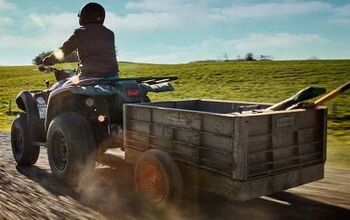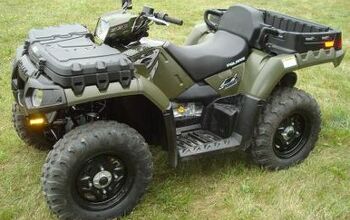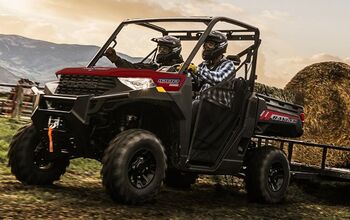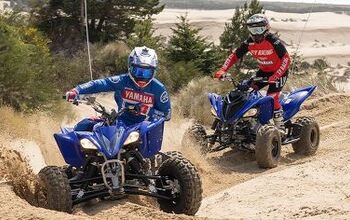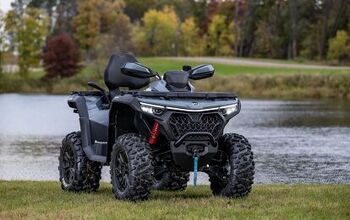2015 Polaris RZR 900 Preview
Among Polaris‘ many new and updated 2015 models, perhaps most shocking is the 50-inch RZR 900.
Polaris took the off-road world by storm in the 2008 model year with the industry’s first Sport-specific UTV – the RZR. Its name was later changed to the RZR 800, but outside of some minor tweaks, it was essentially the same machine for seven model years. It’s the machine that helped move Polaris to the top of the sales charts and created the Sport Side-by-Side market. To call it a success is a wild understatement.
Polaris’ trusty 760cc Inline Twin has been given the boot for 2015 – not just in the RZR, but throughout Polaris’ ATV and UTV lineup. The RZR 900 is powered by the ProStar 900, which we first saw in the 2011 RZR XP 900. While the bump in displacement may seem relatively minor on paper (a gain of 115 cubic centimeters), in reality it translates to a near 50% horsepower increase – the RZR 800 produced 53.2 horsepower compared to a claimed 75 ponies from the new RZR 900 – and 15% bump in torque. That seems like a direct shot across the bow of Arctic Cat and its 50-inch offering – the Wildcat Trail.
Polaris upped the ante when it comes to performance in a 50-inch Sport Side-by-Side with the 75-horsepower 2015 RZR 900.
Polaris has shown it can get considerably more power out of ProStar 900, as the 2014 RZR 900 (formerly RZR XP 900) produced about 88 horsepower. Polaris likely toned it down so it was better suited for trail riding and perhaps a bit safer for a machine that is 14 inches narrower.
2014 Polaris RZR 800 vs. Arctic Cat Wildcat Trail – Specs Shootout
To better handle the power increase, Polaris upped the suspension capabilities of the RZR 900. Dual-Arms are found front and rear and the ZF Sachs shocks dole out 10 inches of travel (front and rear) through dual rate springs. Ground clearance is slightly increased to 11 inches, while the wheel base has been stretched a little to 79 inches.
As for handling, Polaris notes that the RZR 900 benefits from an improved two-turn, lock-to-lock steering ratio. As well, Polaris says the unit’s tubular chassis is stiffer and more durable.
Dual A-arm suspension front and rear doles out 10 inches of travel and provides 11 inches of ground clearance.
Seating has also been addressed for 2015. According to Polaris, the 2015 seats offer improved bolstering and twice as much hip cushioning. As well, a new thin-film technology under the cover is designed for a drier ride in wet conditions.
One thing we’ve been waiting for since riding the original RZR is an easily adjustable seat. While not on the standard RZR 900, LE models will benefit from a seat slider that allows for tool-less seat adjustment and additional legroom.
The steering wheel was never an area of concern for us, but Polaris has made a stiffer design for 2015 that it says is more responsive.
For trails that require a maximum width of 50 inches, you’ll appreciate a machine like the RZR 900.
A new safety feature we applaud is the addition of factory-installed quarter doors, which should offer a level of protection against trail debris and help driver and passenger keep their feet within the safety of the machine.
Polaris outfitted the 2015 RZR 900 with its flow-through tongue seat belt design that is supposedly easier to adjust and retract. According to Polaris, the sealed belt retractor housing ensures the belts operate properly even when riding in the nastiest conditions.
COMPARISON: Read our review of the 2010 Polaris Ranger RZR
More power typically required more fuel and Polaris has addressed that by upping the fuel capacity from 7.25 gallons to 9.5 gallons.
Inside the cockpit, the 50-inch RZR features LED floor lighting and a blue back-lighted instrument cluster, which Polaris says is readable both in direct sunlight and at night.
Polaris offers a host of accessories ready to fit the RZR 900.
Additional storage space comes courtesy of a center storage area and a larger glove box. As well, Polaris says a deeper rear box hold even more cargo.
For those who like to ride in the slop, sealed floor seams and equipment pass-throughs are designed to keep the rider and passenger cleaner. For those times you do run through the deep stuff, dual removable floor drains should make it easy to get the muddy water out of the cockpit.
Every vehicle requires service and Polaris says it made the RZR 900 easier to maintain by placing major components where they can be simply accessed. The air filter, spark plugs and oil fill are now located under the removable box panel in the cargo box of the vehicle. As well, a panel between the seats houses the dipstick and oil filter, and is accessible without removing the seats.
An integrated transmission has only one check/fill point and grease zerks for both the inboard and outboard bushings of the A-arms. To add electric accessories easier, the RZR 900 features a terminal block for wiring under the hood and a bigger battery with 44 Amp-hours of capacity and 575 cold-cranking amps.
You can’t have upgrades like this without a price bump and the RZR 900 hold true to that. While the 2014 RZR 800 retailed for $11,499, the 2015 version will set you back $12,799. That’s an $1,800 premium over its only non-Polaris competitor – the Arctic Cat Wildcat Trail. Pricewise, the RZR 570 ($10,299) is far closer in price to the Wildcat Trail ($10,999). Polaris is giving entry-level Sport Side-by-Side riders a tough decision to make. However, with its years-long domination of the segment, Polaris appears to feel confident consumers will stay on Team RZR.
COMPARISON: Read our review of the 2013 Polaris RZR S 800
Polaris offers the RZR 900 is Polaris Pursuit Camo ($13,499). If you want power steering, you’ll have to jump up to the 55-inch RZR 900 EPS Trail models ($14,799), which also come with Polaris’ High-Performance All-Wheel Drive, engine braking and Turf mode.
The RZR XP 900 EPS Trail is 55 inches wide and features electronic power steering.
Polaris also replaced the RZR S 800 with the RZR S 900 (starting at $14,699). This 60-inch model is available in several iterations and features the same 75-horsepower ProStar 900 engine and 79-inch wheelbase. Beyond its added width, the RZR S 900 offers an increased 12.25 inches of suspension travel up front and 13.2 inches in the rear to go along with 12.5 inches of ground clearance. It also benefits from eight-ply 27-inch GBC Dirt Commander tires.
Offering improve high-speed handling, the 2015 RZR S 900 provides a whopping 13.2 inches of rear suspension travel.
| 2015 Polaris RZR 900 Specs | |
| MSRP: | $12,799 |
| Engine: | 875cc Liquid-Cooled 4-Stroke DOHC Twin Cylinder |
| Induction: | Electronic fuel injection |
| Transmission: | Automatic PVT P/R/N/L/H |
| Drive System: | On-Demand True AWD/2WD |
| Engine Braking/Active Descent Control: | Standard/Not Equipped |
| Front Suspension: | Dual A-Arm with Anti-Sway Bar 10″ (25.4 cm) Travel |
| Rear Suspension: | Dual A-Arm with Anti-Sway Bar 10″ (25.4 cm) Travel |
| Front/Rear Brakes: | 4-Wheel Hydraulic Disc with Dual-Bore Front Calipers |
| Parking Brake: | Park in Transmission |
| Front Tires: | 26 x 8-12; PXT |
| Rear Tires: | 26 x 9-12; PXT |
| Wheels: | Cast Aluminum |
| Length/Width/Height: | 105 x 50 x 69.5 in |
| Dry Weight: | 1,174 lbs |
| Wheelbase: | 79 in |
| Ground Clearance: | 11.0 in |
| Fuel Capacity: | 9.5 gal |
| Bed Box Dimensions: | 20.7 x 37 x 7.9 in |
| Box Capacity: | 300 lbs |
| Payload Capacity: | 740 lbs |
| Towing Capacity: | 1,500 lbs |
| Hitch Type: | Standard 1.25 in Receiver |
| Cargo System: | Lock & Ride |
| Electronic Power Steering: | Not on this model |
| Lighting: | Halogen, 55W Low/ 60W High & Red LED Tail / Brake Lights |
| Instrumentation: | Digital Gauge, Speedometer, Odometer, Tripmeter, Tachometer, Coolant Temperature, Volt Meter, Hour Meter, Service Indicator, Clock, Gear Indicator, Fuel Gauge, Hi-Temp Light, Seatbelt Reminder Light, DC Outlet |
| Colors: | Black Pearl, Sunset Red, Polaris Pursuit Camo |
I have been working exclusively in digital media since 1997. I started out with TSN.ca, spending nearly nine years creating and editing content on Canada's leading sports website. I left to join VerticalScope, Inc., one of the world's largest online publishers, to start a number of powersports publications. While at VerticalScope, I've helped create and oversee content for a wide variety of different publications, including ATV.com, Off-Road.com, ArcheryTalk.com, Tractor.com, RVGuide.com, and many more.
More by Lucas Cooney




